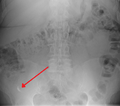Wikipedia:VideoWiki/Appendicitis
Definition
Appendicitis is inflammation of the appendix.

Symptoms
Symptoms commonly include right lower abdominal pain, nausea, vomiting, and decreased appetite. However, approximately 40% of people do not have these typical symptoms.
Symptoms with rupture
Severe complications of a ruptured appendix include widespread, painful inflammation of the inner lining of the abdominal wall, and sepsis.

Causes
Appendicitis is caused by a blockage of the hollow portion of the appendix. This is most commonly due to a calcified "stone", made of feces.

Etiology of blockage
Inflamed lymphoid tissue from a viral infection, parasites, gallstone, or tumors may also cause the blockage.

Pathophysiology
This blockage leads to increased pressures in the appendix, decreased blood flow to the tissues of the appendix, and bacterial growth inside the appendix causing inflammation.

Necrosis
The combination of inflammation, reduced blood flow to the appendix, and distention of the appendix causes tissue injury, and tissue death. If this process is left untreated, the appendix may burst, releasing bacteria into the abdominal cavity, leading to increased complications.

Diagnosis
The diagnosis of appendicitis is largely based on the person's signs, and symptoms. In cases where the diagnosis is unclear, close observation, medical imaging, and laboratory tests can be helpful.

Imaging
The two most common imaging tests used are an ultrasound, and computed tomography (otherwise known as a CT scan).

CT vs ultrasound
CT scan has been shown to be more accurate, than ultrasound in detecting acute appendicitis, but with children and pregnant women, ultrasound may be used to limit radiation exposure.
Treatment
The standard treatment for acute appendicitis is surgical removal of the appendix.

Open vs closed
This may be done by an open incision in the abdomen (called a laparotomy), or through a few smaller incisions with the help of cameras (which is called laparoscopy). Surgery decreases the risk of side effects, or death, associated with rupture of the appendix.

Antibiotics
Antibiotics may be equally effective in certain cases of non-ruptured appendicitis.

Epidemiology
Appendicitis is one of the most common, and significant causes of severe abdominal pain, that comes on quickly. In 2015, about 11.6 million cases of appendicitis occurred, which resulted in about 50,100 deaths.

National burden in US
In the United States, appendicitis is the most common cause of sudden abdominal pain requiring surgery. Each year in the United States, more than 300,000 people with appendicitis, have their appendix surgically removed.

History
Reginald Fitz is credited with being the first person to describe the condition, in the english language literature, in 1886.
